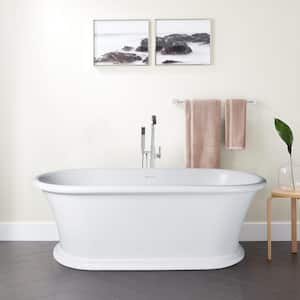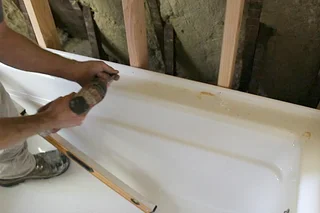Exactly How To Replace A Tub (For Beginners).
Exactly How To Replace A Tub (For Beginners).
Blog Article
They are making a number of great points relating to A Step-by-Step Guide to Installing a Bathtub overall in the article down below.

Mounting a bathtub isn't precisely brain surgery, but it does need strong plumbing, woodworking, as well as occasionally, tiling skills. Replacing an old tub with a brand-new one is also a moderately tough task. If the old tub is easily obtainable, the project can move immediately; if you need to open up a wall to remove the old tub and also place the brand-new bath tub, the job is much harder. In either instance, the project is within a home handyman's skills, although you will certainly require an assistant to move out the old tub as well as embeded in the brand-new one. See to it you have actually qualified yourself for the task and also fit trying it. Rather than hiring a professional to take control of a halfway-completed job, it is far better to take into consideration utilizing one prior to you start. Opportunities are you might require an expert plumber to make tube links.
This write-up will certainly aid you mount a brand-new bath tub in your bathroom if you have actually currently acquired a brand-new bathtub and also do not require to transform the setup of your previous water pipelines.
Your devices and also product list need to consist of the following:
Removing Old Taps
If you need to replace old faucets with brand-new ones as a part of your installment, after that the first thing you must do is detach the supply of water. After doing so, switch on the taps to drain any kind of water continuing to be in the system. The procedure of eliminating the existing faucets can be rather troublesome due to the restricted accessibility that is usually the instance.
Make use of a container wrench (crowsfoot spanner) or a tap tool to reverse the nut that attaches the supply pipelines to the taps. Have a cloth all set for the continuing to be water that will certainly come from the pipes. As soon as the supply pipelines have been removed, make use of the very same tool to loosen the nut that holds the faucets onto the bath/basin. You will certainly require to stop the solitary faucets from turning during this procedure. When the taps have actually been gotten rid of, the holes in the bath/basin will have to be cleansed of any type of old sealing substance.
Prior to proceeding to fit the new faucets, compare the pipe links on the old taps to the brand-new faucets. If the old taps are longer than the brand-new faucets, then a shank adapter is needed for the brand-new taps to fit.
Suitable New Taps
If the tails of the brand-new faucets are plastic, then you will certainly need a plastic connector to stop damage to the string. One end of the port fits on the plastic tail of the tap and also the other end provides a link to the existent supply pipelines.
If you need to fit a monobloc, after that you will certainly require minimizing couplers, which connects the 10mm pipeline of the monobloc to the basic 15mm supply pipeline.
Next, place the tap in the placing hole in the bath/basin ensuring that the washers are in area in between the tap and also the sink. Secure the faucet in place with the supplier offered backnut. As soon as the tap is firmly in place, the supply pipelines can be connected to the tails of the faucets. The taps can either be linked by using corrugated copper piping or with typical faucet connectors. The previous kind ought to be attached to the tap finishes first, tightening up just by hand. The supply pipes can later on be connected to the various other end. Tighten up both ends with a spanner after both ends have been attached.
Installing the Tub
Making use of the two wood boards under its feet, place the tub in the called for position. The wood boards are helpful in uniformly spreading out the weight of the bathtub over the area of the boards rather than concentrating all the weight onto four little points.
The next objective is to guarantee that the tub is leveled all round. This can be attained by checking the level and also adjusting the feet on the tub till the level reads level.
To mount faucets, fit the bottom of the furthest adaptable faucet connector to the appropriate supply pipeline by making a compression join; then do the very same for the various other faucet.
Switch on the water system and also check all joints as well as brand-new pipework for leakages and also tighten them if required. Fill up the bath tub as well as also check the overflow outlet as well as the regular electrical outlet for leaks.
Lastly, take care of the bathroom paneling as defined in the manufacturer's instruction manual. Tiling as well as securing around the tub needs to wait till the tub has actually been made use of at least when as this will certainly resolve it right into its final position.
Preparing for the Setup
First of all, the sustaining structure provided with the bathroom needs to be fitted (if called for) according to the supplier's instructions. Next, fit the taps or mixer to the bathtub. When fitting the tap block, it is important to ensure that if the tap comes with a plastic washer, it is fitted between the bath as well as the faucets. On a plastic bathroom, it is likewise sensible to fit a supporting plate under the taps unit to prevent strain on the bath tub.
Fit the adaptable faucet adapters to the bottom of both faucets utilizing 2 nuts as well as olives (in some cases supplied with the tub). Fit the plug-hole outlet by smearing mastic filler round the sink outlet hole, and afterwards pass the electrical outlet through the hole in the bath. Use the nut supplied by the manufacturer to fit the plug-hole. Check out the plug-hole electrical outlet for an inlet on the side for the overflow pipe.
Next, fit completion of the adaptable overflow pipe to the overflow outlet. After that, screw the pipeline to the overflow face which need to be fitted inside the bathroom. Ensure you use all of the provided washing machines.
Link the trap to the bottom of the waste electrical outlet on the bath tub by winding the string of the waste outlet with silicone mastic or PTFE tape, and screw on the trap to the outlet. Connect the bottom of the overflow tube in a similar manner.The bathroom should currently be ready to be fitted in its final setting.
Tiling Around the Tub
In the area where the bathroom satisfies the ceramic tile, it is required to seal the joins with a silicone rubber caulking. This is essential as the fitting can move enough to fracture an inflexible seal, creating the water to pass through the wall surface in between the bathroom as well as the tiling, resulting in problems with dampness and also feasible leakages to the ceiling listed below.
You can choose from a selection of coloured sealants to blend in your fixtures and also installations. They are offered in tubes and cartridges, and also can sealing gaps approximately a size of 3mm (1/8 inch). If you have a bigger gap to fill, you can load it with spins of soaked newspaper or soft rope. Remember to constantly fill up the bathtub with water prior to sealing, to enable the movement experienced when the bathtub is in usage. The sealant can crack relatively early if you do not think about this movement prior to sealing.
Conversely, ceramic coving or quadrant tiles can be utilized to border the bath or shower tray. Plastic strips of coving, which are easy to use and also cut to dimension, are also quickly readily available on the market. It is suggested to fit the ceramic tiles making use of water-resistant or water resistant glue and cement.
Bathtub Installation
How Important Is A Bathtub To Your Home?
High-quality baths, showers, and other bathroom updates are necessary when considering a smart investment in your home. It’s a room that you go to every day and one that is constantly being used by guests.The bathroom is one of the top trafficked rooms in a home and also one of the most valuable in terms of home resale.
Install Piping Before Tub
You will be using your existing drain and waste vent system, but pipes required include the hot and cold water supply lines and a pipe leading to a shower head. A mixing valve and shower head are also needed. Air chambers may be required.
Position the Tub
Lower the tub into place so that the continuous flange fits against the wall studs and rests on 1’x4' or 2’x4' supports. Anchor the tub to the enclosure with nails or screws inserted through the flanges into the studs.
NOTE: Remember, bathtubs and shower stalls may require support framing. A bathtub filled with water is extremely heavy, so check building codes and framing support before installing the tub.
Assemble Drain Connections
Assemble the bathtub drain connections by connecting the tub overflow with the tub drain above the trap, not beyond it. The trap will have a compression fitting that screws over the arm of the overflow assembly.
Place a Pipe For the Shower Head
First, locate a brass female threaded winged fitting and attach it to a framing support via a screw or a nail. Then run a pipe up the wall for the shower head. Sweat or solder the other side of the brass fitting to the top of the pipe.
Attaching Hot and Cold Water Lines
Attach your water lines for both hot and cold by sweating these directly into the hot and cold ports of the mixing valve. The mixing valve will be how water enters the tub’s system, not by the pipes themselves.
Install the Spout
Extend a piece of 1/2 inch pipe, or whichever length is specified in the manufacturer’s instructions, for the tub spout. Sweat on a male threaded fitting at the end of the pipe or use a brass nipple of the proper length and a 1/2 inch cap.
NOTE: At this point you should have your rough-in plumbing work inspected before proceeding further.
Check For Leaks
Restore the water pressure and check the drain connection and the supply pipes for any sign of leaking.
estore the Bathroom Wall
Replace the wall with moisture-resistant drywall as a base for your wall covering. Seal the joints between the wall and your new tub with silicone caulk as protection against water seepage.
https://www.berkeys.com/2016/12/02/bathtub-installation-dallas/

I'm just very taken with Tools You Need to Install a New Bathtub and I really hope you enjoyed reading our blog posting. Do you know another person who is truly interested in How to Install a Bathtub: Install an Acrylic Tub and Tub Surround? Do not hesitate to share it. I thank you for reading our article about A Step-by-Step Guide to Installing a Bathtub.
Book Your Service Report this page